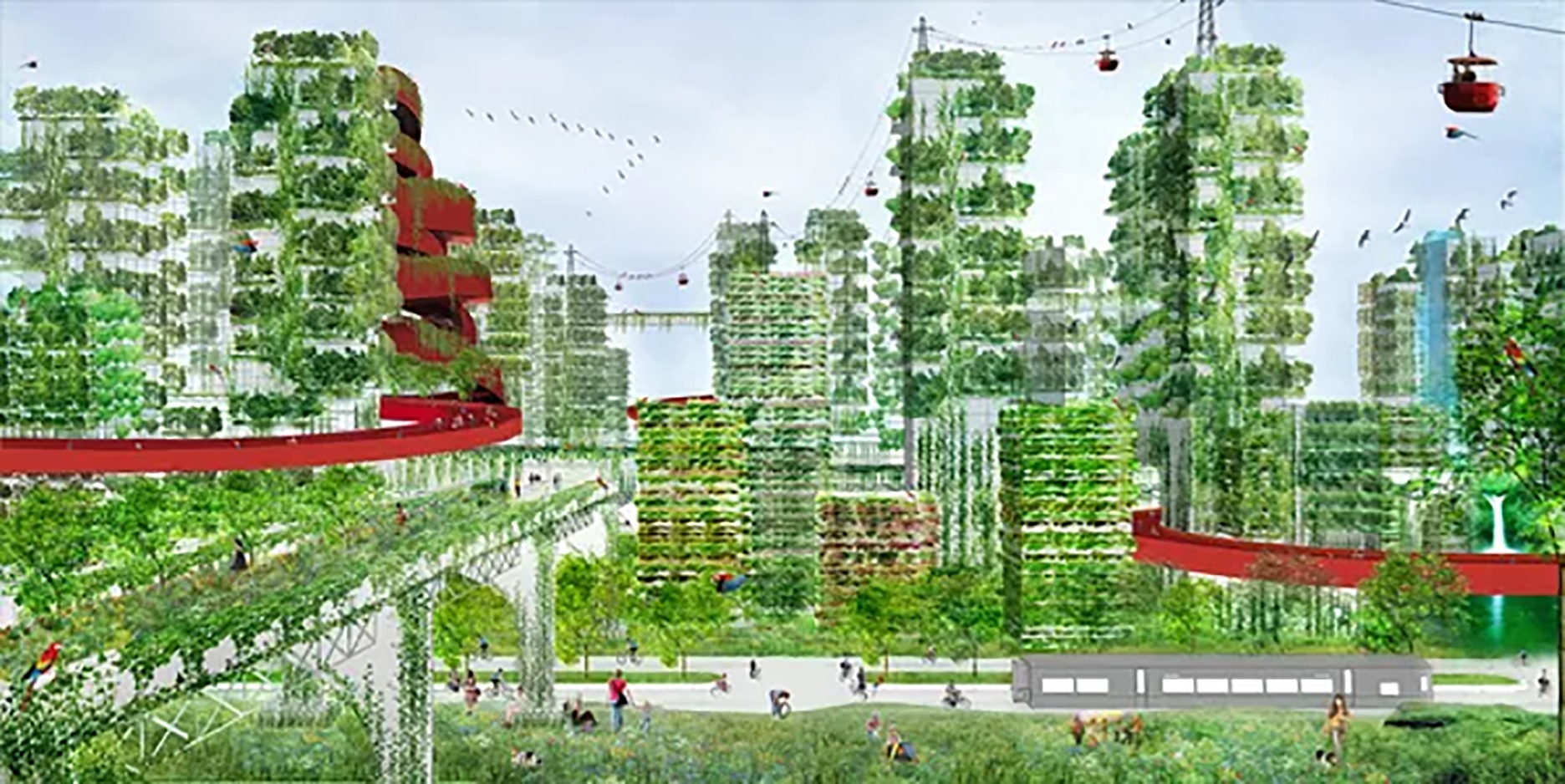
The world is in constant need of novelty, real or imagined. The myth of unstoppable progress did not die with the end of industrial capitalism fifty years ago, when mankind realised that it is not possible to increase production indefinitely, but it is possible to increase consumer interest by giving the product a more ‘useful’ image. Products and services labelled as ‘bio’, ‘eco’, ‘green’ are now everywhere.
The same is true in fields such as town planning and architecture: the latest trend is ‘greening’, an opaque and vague concept that is, however, really changing our cities.
Previously, parks, squares, alleys and gardens were the focus of urban green spaces. But in the ‘stone jungle’ there is always a shortage of space, resulting in high building density, and there is simply no room for much-needed green space. Greening has been an alternative solution, a new concept of urban greenery using vertical and horizontal planes in buildings, including techniques such as green roofs, green floors and walls, and vertical forests[1].
Greening (‘greening’, ‘green architecture’) consists of creating a sustainable residential building, which contributes to the restoration of the environment and biodiversity of the urban ecosystem, without extending the area of the city. The main targets of this concept are megacities. Simply put, it is a model of vertical compaction of nature within a city[2].
Greening aims at improving the ecological situation of densely populated cities: softening the microclimate, partially taking over thermoregulation functions, cleaning the air, reducing the intensity of solar radiation and the level of noise pollution. It also changes the flora and fauna, attracting birds and insects, and creates ecological corridors with existing parks, squares and alleys[3], as well as having a positive psychological impact on people[4].
Project implementation and operating principles
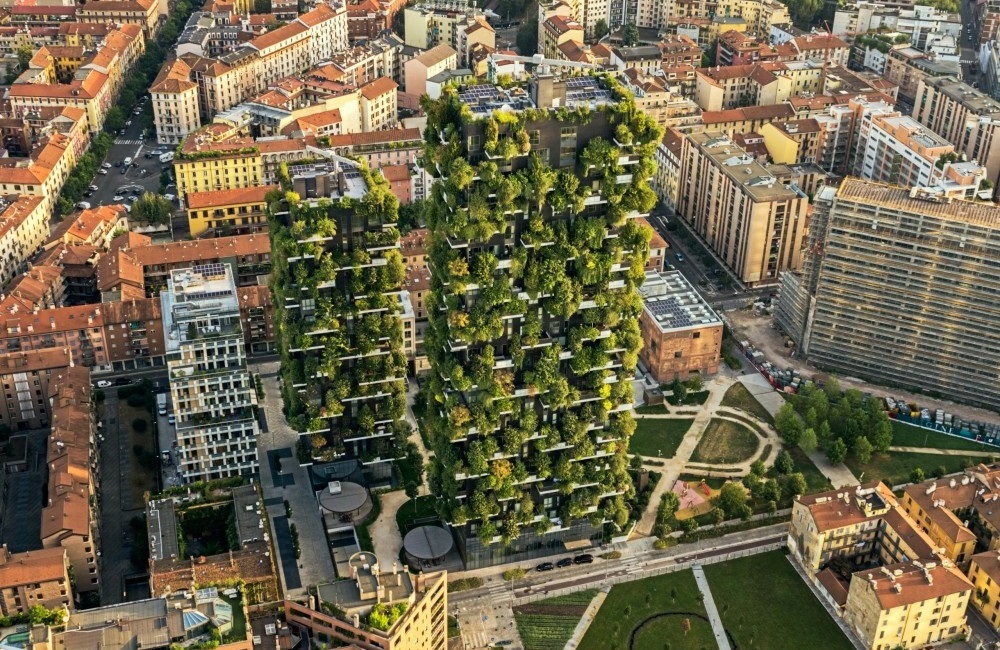
Bosco Verticale in Milan[5]
In 2014, the Bosco Verticale complex was completed in Milan, in the Porta Nuova area, the first prototype of biodiversity architecture with an embodied vertical forest concept, which is the most striking representative of greening to date. Two towers, 80 and 112 metres high, contain a total of 800 trees of different heights, 5,000 shrubs and around 15,000 terrestrial perennials. The landscape, which amounts to 30,000 green plants[6], covers an urban area of 3,000 square metres. And each tower is equivalent to 50,000 square metres of urban development with buildings and single-family houses[7].
The towers were designed by Italian architect Stefano Boeri and his partners in the Boeri studio – Gianandrea Barreca and Giovanni La Varra[8]. The facades of the towers were designed as large stepped balconies, which provide space for large baskets of plants and allow large trees, some up to three storeys high, to grow unhindered[9]. The types of plants and their arrangement were chosen so that the building changes its appearance according to the season, demonstrating the seasonal changes in the dynamics of greenery[10].
The design of the vegetation was a preliminary step in the construction process. The plants were carefully selected during a three-year trial period, in collaboration with a team of botanists, because the flora must not only be visually attractive, but also meet certain standards: it must be small enough to take root, resistant to pests and diseases, require a moderate amount of moisture, be allergen-free and non-toxic[11]. The plants intended to be part of the vertical forest were grown in a special botanical nursery. Already during the construction phase, the plants were planted and their adaptation monitored. Due to the extreme growing conditions (height of 100 metres and possibility of strong winds), the trees were tested in a wind laboratory in Miami, USA[12].
The landscaping elements are maintained by two cranes attached to the roof of the skyscrapers. The initial idea was to have gardeners move around the façade on a platform, but this proved difficult and expensive, so now the plants are cared for by climbing gardeners[13]. They prune, shape and, if necessary, replace the bushes and trees[14]. On the other hand, irrigation is not used professionally, but is carried out centrally by a network of irrigation elements that partly use the waste water filtered by the towers[15]. Already a few years after construction, it was possible to achieve an expansion of the habitat for birds, butterflies and other insects, expanding their colonisation by 1600 individuals, creating a new stronghold for the city’s flora and fauna[16].
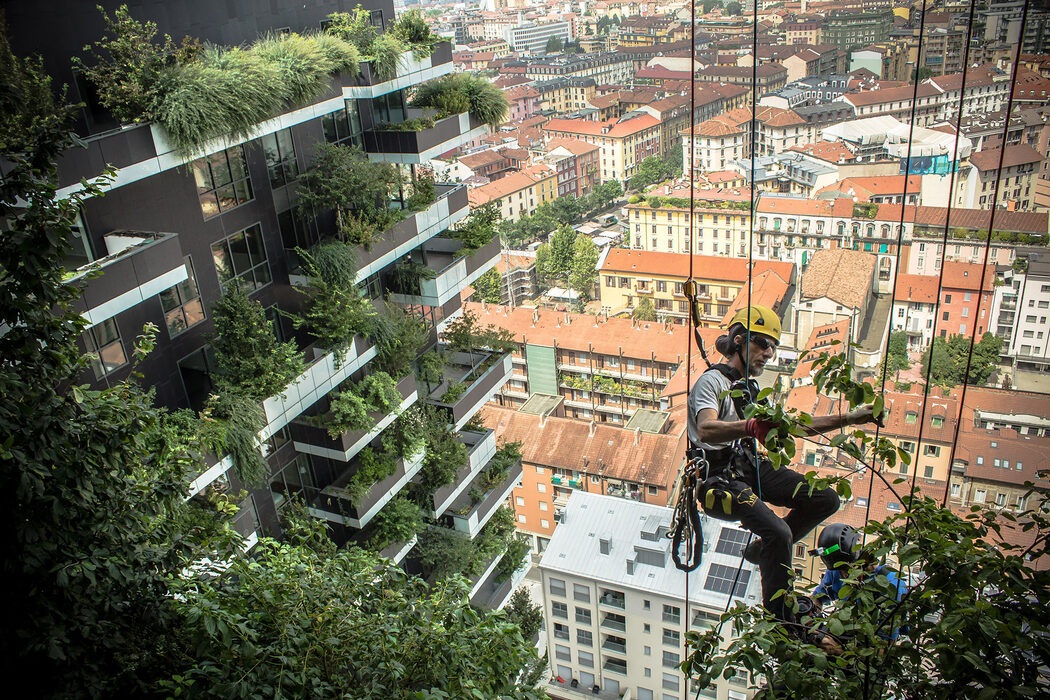
Plant care at the Bosco Verticale[17]
The Vertical Forest is the best known and most striking representative of the Greening concept, but it is not the only one. In 2022, another project by Boeri Studio has been commissioned, the Easyhome Huanggang Vertical Forest City complex, ‘green-clad’ buildings that combine both residential buildings and commercial spaces and hotels. The complex is built in the city of Huanggang, Hubei Province, China. More than 400 trees, 4,620 shrubs and a large number of perennial grasses, flowers and climbing plants were used for the landscaping. According to preliminary calculations, the greenery in this complex is expected to absorb 22 tonnes of carbon dioxide and produce 11 tonnes per year of clean air[18].
Since 2016, the centre of Sydney, Australia, has been graced by Jean Nouvel’s One Central Park ‘green creation’ in collaboration with botanical artist Patrick Blank, two towers of 34 and 12 storeys with a vertical landscape occupying 50% of the façade area. The project uses hydroponic walls, low-profile horizontal pots and cables anchored to the facades of the towers to support the growth of climbing plants[19]. In addition, there is a mobile mirror system on the console that redirects the sun’s rays to the lower levels of the ‘vertical garden’. The project stands as an object for ‘an integrated experience of living in harmony with the natural world’[20].
Nouvel and Blank’s joint work can also be seen in the prestigious central district of Kualo Lumpur, Malaysia: the Le Nouvel KLCC residential complex, 195 luxury flats located in two towers connected by a pool and sky bridge, with a façade that is striking for its combination of greenery and glass[21]. Other world-renowned projects: the Santalaia residential building in the Colombian capital Bogotá, the KÖ-Bogen II commercial and office building with an 8 km hedge in Düsseldorf, Germany, the 70 m high Aglaya residential tower in the Swiss town of Rotkreuz, the Tour de la Biodiversité in Paris, France: green is popping up in architectural solutions all over the world[22].
Renewing gentrification
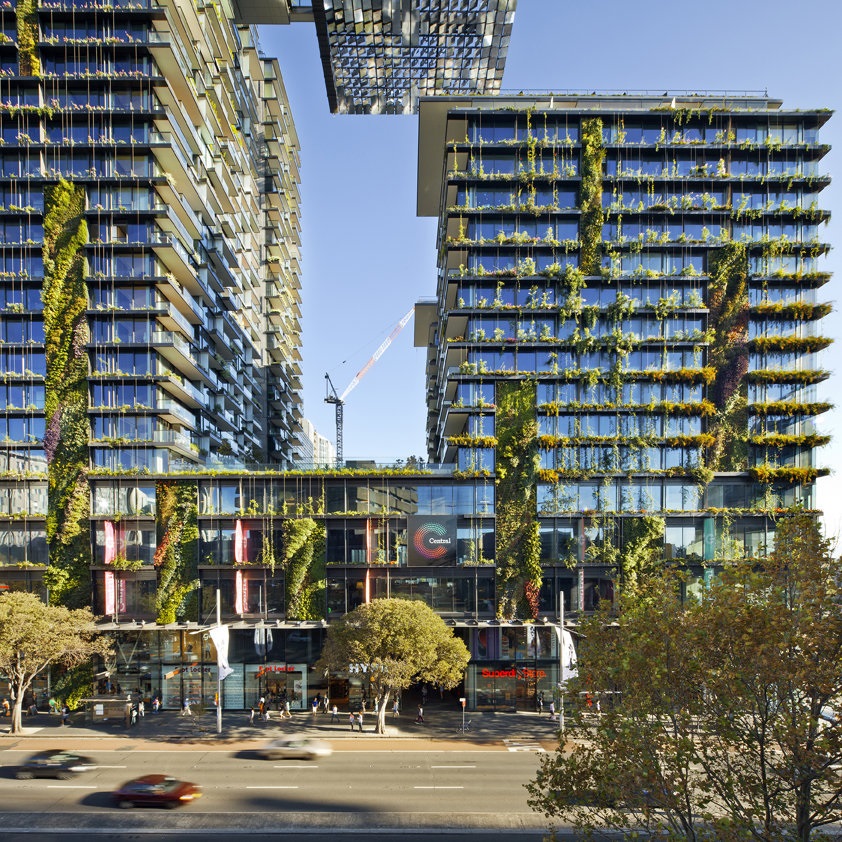
One Central Park apartment complex, Sydney, Australia[23]
All the projects completed so far are prestigious homes in good neighbourhoods. The complexity of the design, the work of preparing the future ‘green roofs’ and their testing, the costs of operation and maintenance, and other factors make a rather large number of square metres of ‘living with nature’ unaffordable for ordinary residents, who are unable to bear the costs[24].
To be fair, the architectural firm Stefano Boeri has designed Vertical Forest Trudo, in Eindhoven, the Netherlands, a 19-storey apartment complex that positions itself as the first social vertical forest[25]. Each flat is small (up to 50 m²), but with a large terrace in a 70 metre high tower, landscaped with 135 trees and over 10,000 smaller plants. Of the 125 flats, 30 are available for social housing at an affordable rent (633.20 euro per month)[26].
A six-year study conducted by scientists from the Institute of Environmental Science and Technology (L’Institut de Ciència i Tecnologia Ambientals, ICTA) of the Universitat Autònoma de Barcelona, directed by geographer and sociologist Isabelle Anguelovski, revealed that gentrification processes occur in cities that actively implement greening policies[27].
The active implementation of municipal greening strategies undoubtedly increases the attractiveness of housing, resulting in increased interest from residents with greater purchasing power. This demand, in turn, raises the price of buying, renting and maintaining housing, displacing the most vulnerable social groups, who cannot afford the costs and are forced to move to areas with a lower quality of life[28].
An analysis by the Greenlulus[29] project on the housing market and socio-demographic conditions of 28 cities in nine European and North American countries found that greening has accelerated gentrification in 17 cities[30].
There is no doubt that greening has proven socio-economic and climatic benefits and has a positive impact on the psycho-physical well-being of residents, but it is not a public good but a ‘luxury item’. The issue of equity and fairness in the distribution of and access to green spaces should dominate city-wide green planning. Greening should be supported by policies to control property speculation, encourage social housing, and green all parts of the city, not just the financially attractive central areas[31].
Some legitimate doubts
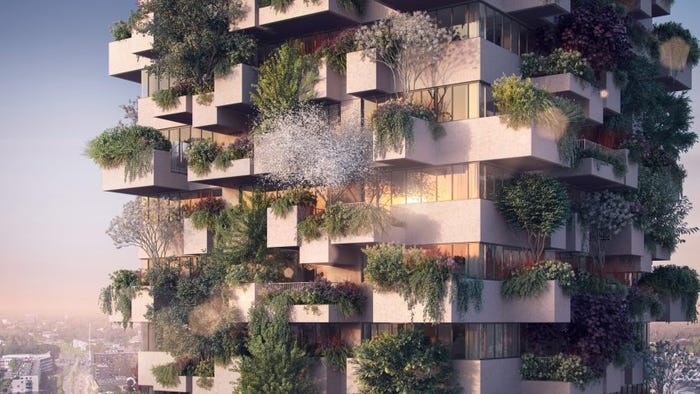
Vertical Forest Trudo in Eindhoven[32]
The main idea of greening is to improve the climate and biodiversity of densely populated cities. Sounds great, but…
One of the goals behind this architectural trend is to take care of the environment, i.e. to help solve the global problem. But what is the carbon dioxide conversion efficiency for plants at high altitude, and is it commensurate with the sulphur energy used in the construction of these concrete buildings, concrete gutters, terraces and balconies[33]? No one makes comparative calculations after the construction has been completed.
The issue of bringing nature back to megacities is very important and requires innovative and intelligent solutions; in every big city there are organisations working to make cities greener[34]. The European Commission, for example, has drawn up a plan to green cities with at least 20,000 inhabitants in order to preserve and protect urban ecosystems and improve urban biodiversity[35].
Greening of roofs, vertical greening of existing buildings, expansion of green cover in gardens and public parks, massive planting of trees, and the use of biophilic design in existing public buildings are just some of the measures for restoring and developing green infrastructure, which can be an economical and useful solution to ‘reclaim’ nature in large cities[36].
Projects by leading greening architecture firms include dozens of ambitious designs for megacities around the world, from ‘forest cities’ in China[37] to ‘green urban oases’ in Asia and North East Africa[38]. In an attempt to radically solve global problems that have been building up for decades, we get exclusive multi-million dollar proposals that are undeniably very impressive, but very ineffective; moreover, they can only be called ‘green’ in inverted commas.
When one looks at the majestic representatives of greening, after years of building and experimenting with plants, with massive concrete structures filled with ultra-light substrate, with super modern irrigation systems with lots of sensors, brackets, tanks, pipes and hoses, to ensure the life of the green façades, there is no desire to do the math and analyse the total impact on the climate[39], nor to pay attention to the natives of these areas, because it is already beautiful as it is.
[1] https://izron.ru/articles/voprosy-tekhnicheskikh-nauk-novye-podkhody-v-reshenii-aktualnykh-problem-sbornik-nauchnykh-trudov-po/sektsiya-10-stroitelstvo-i-arkhitektura-spetsialnost-05-23-00/sovremennye-tendentsii-ozeleneniya-primenyaemye-v-mnogoetazhnykh-zhilykh-domakh-i-ikh-relevantnost-v/
[2] https://urbannext.net/vertical-forest/
[3] https://urbannext.net/vertical-forest/
[4] https://izron.ru/articles/voprosy-tekhnicheskikh-nauk-novye-podkhody-v-reshenii-aktualnykh-problem-sbornik-nauchnykh-trudov-po/sektsiya-10-stroitelstvo-i-arkhitektura-spetsialnost-05-23-00/sovremennye-tendentsii-ozeleneniya-primenyaemye-v-mnogoetazhnykh-zhilykh-domakh-i-ikh-relevantnost-v/
[5] https://www.hausvoneden.de/urban-living/bosco-verticale-sind-waldtuerme-die-zukunft-des-nachhaltigen-designs/
[6] https://www.stefanoboeriarchitetti.net/project/bosco-verticale/
[7] https://urbannext.net/vertical-forest/
[8] https://www.stefanoboeriarchitetti.net/project/bosco-verticale/
[9] https://www.stefanoboeriarchitetti.net/project/bosco-verticale/
[10] https://italy4.me/lombardia/milan/neboskryob-bosko-vertikale-vertikalnyj-les-v-milane.html
[11] https://cradle-mag.de/artikel/bosco-verticale-waldtuerme-zum-wohnen.html
[12] https://www.stylepark.com/de/news/stefano-boeri-bosco-verticale-konzept-vertikaler-wald-stylepark
[13] https://www.stylepark.com/de/news/stefano-boeri-bosco-verticale-konzept-vertikaler-wald-stylepark
[14] https://gozakordon.com/europe/italy/boskovertikale-milan
[15] https://www.stefanoboeriarchitetti.net/project/bosco-verticale/
[16] https://www.stefanoboeriarchitetti.net/project/bosco-verticale/
[17] https://www.stylepark.com/de/news/stefano-boeri-bosco-verticale-konzept-vertikaler-wald-stylepark
[18] https://www.archdaily.com/975710/easyhome-huanggang-vertical-forest-city-complex-stefano-boeri-architetti
[19] http://www.jeannouvel.com/en/projects/one-central-park/
[20] https://www.archdaily.com/551329/one-central-park-jean-nouvel-patrick-blanc
[21] https://www.henrywiltshire.com.hk/news/developments/le-nouvel-klcc-architectural-masterpiece-kuala-lumpur/
[22] https://magazin.schindler.de/architektur/gruene-hochhaeuser
[23] https://www.verticalgardenpatrickblanc.com/realisations/sydney/one-central-park-sydney
[24] https://cradle-mag.de/artikel/bosco-verticale-waldtuerme-zum-wohnen.html
[25] https://www.vdberk.com/projects/vertical-forest-eindhoven/
[26] https://decor.design/vertikalnyj-les-trudo-stefano-boeri-architetti/
[27] https://22century.ru/ecology/29836
[28] https://www.winstein.org/publ/1-1-0-7502
[29] https://www.bcnuej.org/projects/greenlulus/
[30] https://www.winstein.org/publ/1-1-0-7502
[31] https://www.winstein.org/publ/1-1-0-7502
[32] https://www.businessinsider.com/plant-covered-affordable-housing-skyscraper-stefano-boeri-2018-1
[33] https://www.nzz.ch/feuilleton/das-erste-gartenhochhaus-der-schweiz-ein-paar-baeume-auf-50-metern-hoehe-sind-kein-wald-ld.1524158
[34] https://theconversation.com/urban-greening-can-save-species-cool-warming-cities-and-make-us-happy-116000
[35] https://environment.ec.europa.eu/topics/urban-environment/urban-greening-platform_en
[36] https://theconversation.com/urban-greening-can-save-species-cool-warming-cities-and-make-us-happy-116000
[37] https://www.stefanoboeriarchitetti.net/project/citta-foresta/
[38] https://www.stefanoboeriarchitetti.net/project/green-urban-oases/
[39] https://www.nzz.ch/feuilleton/das-erste-gartenhochhaus-der-schweiz-ein-paar-baeume-auf-50-metern-hoehe-sind-kein-wald-ld.1524158
Leave a Reply